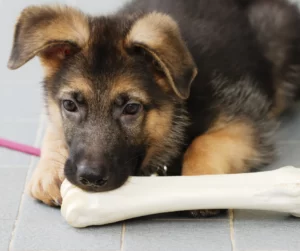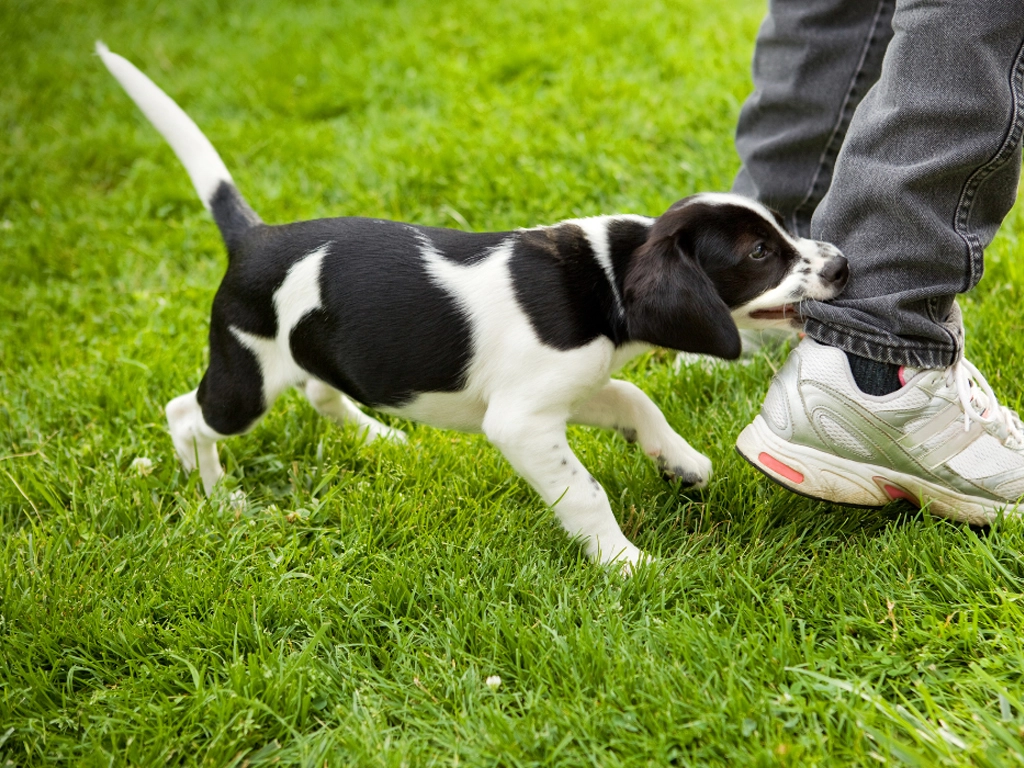The joy of bringing a new puppy home can be slightly marred by their natural tendency to bite. Understanding and addressing this behaviour is essential for a harmonious relationship between the pet and the owner. This article delves into the reasons behind puppy biting, differentiates between playful and aggressive behaviour, and offers practical solutions to manage and train your pup.
Understanding Puppy Biting
Why Puppies Bite
 Puppies explore their world primarily through their mouths, a behaviour stemming from both curiosity and the physiological process of teething. This section will delve into the developmental stages of puppies, highlighting the importance of biting in their sensory and exploratory learning, and the natural progression of this behaviour.
Puppies explore their world primarily through their mouths, a behaviour stemming from both curiosity and the physiological process of teething. This section will delve into the developmental stages of puppies, highlighting the importance of biting in their sensory and exploratory learning, and the natural progression of this behaviour.
The Role of Teething
Teething is a crucial stage in a puppy’s development, often causing discomfort, leading to increased chewing, and biting. We will explore various safe and effective teething remedies and toys, focusing on how they can provide relief and divert biting from inappropriate objects.
Differentiating Playful Biting from Aggressive Behaviour
Recognising Playful Bites
Playful biting is a common behaviour in puppies and is often a part of their learning process. It is gentler and occurs during play, without signs of distress or aggression. Puppies engaging in playful biting may exhibit a relaxed body posture, wagging tails, and may even take breaks between bites. It is a way for them to interact with their environment and learn the limits of their strength. Understanding this behaviour is crucial in guiding and shaping it appropriately. During play, puppies learn bite inhibition, a vital skill where they understand how to control the force of their bite. Encouraging gentle play and providing positive reinforcement when they bite softly or play without biting can help reinforce good behaviour.
Signs of Aggression
Aggressive biting, on the other hand, is a cause for concern and requires immediate attention. This type of biting can be identified by accompanying signs of aggression, such as growling, bared teeth, a stiff body posture, and a focused, intense stare. Aggressive biting may occur due to fear, territorial behaviour, pain, or frustration, and can be more intense and sudden compared to playful biting. Understanding the triggers of such behaviour is key to addressing it effectively. For instance, if a puppy bites aggressively when approached while eating, it might be exhibiting food guarding behaviour.
Responding to Different Types of Biting
How an owner responds to biting can influence future behaviour. For playful biting, owners can redirect the behaviour towards toys or use gentle training techniques to discourage it. In cases of aggressive biting, it is important to stay calm and not punish the puppy harshly, as this can exacerbate the aggression. Instead, seeking the guidance of a professional trainer or behaviourist, especially one experienced in dealing with aggression in dogs, like K9 Principles, is recommended. They can provide targeted strategies to modify the aggressive behaviour safely and effectively.
Training Your Puppy to Stop Biting
Establishing Boundaries
 One of the first steps in training your puppy to stop biting is to establish clear boundaries. It is crucial for puppies to learn what is acceptable to bite and what is not. This training begins by gently discouraging biting when it occurs. For instance, if a puppy bites your hand, you can emit a soft yelp to indicate that it is not acceptable, mimicking the response they would receive from littermates. Following this, redirecting their attention to an appropriate toy or chew item reinforces what they are allowed to bite. Consistency in this practice helps puppies understand these boundaries more quickly.
One of the first steps in training your puppy to stop biting is to establish clear boundaries. It is crucial for puppies to learn what is acceptable to bite and what is not. This training begins by gently discouraging biting when it occurs. For instance, if a puppy bites your hand, you can emit a soft yelp to indicate that it is not acceptable, mimicking the response they would receive from littermates. Following this, redirecting their attention to an appropriate toy or chew item reinforces what they are allowed to bite. Consistency in this practice helps puppies understand these boundaries more quickly.
Effective Training Techniques
Utilising positive reinforcement techniques is highly effective in training puppies to stop biting. This involves rewarding desired behaviours (such as not biting) with treats, praise, or playtime. It is important to reward the puppy immediately after the good behaviour is displayed, to ensure they make the connection between the behaviour and the reward. Negative reinforcement, such as scolding or physical punishment, should be avoided as it can lead to fear and aggression.
Managing Overexcitement and Overstimulation
Often, puppies bite out of overexcitement or overstimulation. Managing the environment to prevent these states can help reduce biting. This includes providing ample physical and mental exercise, such as walks, play sessions, and training exercises. If a puppy becomes too excited, giving them a time-out in a quiet space can help them calm down.
Training Sessions and Consistency
Short, frequent training sessions are more effective than longer, less frequent ones. Consistency across all members of the household in responding to biting is crucial. Everyone should use the same commands and follow the same rules, creating a consistent environment for the puppy to learn in.
Seeking Professional Help
If biting persists or if you are struggling to manage it, we can come see you with our in-home private training to help stop the behaviour. At K9 Principles, we offer tailored in-home training programmes to address specific issues like biting, using methods that are kind and effective. We are located in Caledonia and serve all the Hamilton Area including Haldimand County and parts of Norfolk County.
Addressing Reinforcement of Biting
Understanding and Responding to Biting
 In addressing the reinforcement of biting in puppies, it is crucial to understand the underlying reasons why a puppy may continue this behaviour. Often, biting is inadvertently reinforced by owners’ reactions. For instance, if a puppy bites and receives attention (even if it is negative), they may learn that biting is a way to engage their owner. Understanding this dynamic is the first step in modifying the approach to reduce and eventually eliminate this unwanted behaviour.
In addressing the reinforcement of biting in puppies, it is crucial to understand the underlying reasons why a puppy may continue this behaviour. Often, biting is inadvertently reinforced by owners’ reactions. For instance, if a puppy bites and receives attention (even if it is negative), they may learn that biting is a way to engage their owner. Understanding this dynamic is the first step in modifying the approach to reduce and eventually eliminate this unwanted behaviour.
Identifying Reinforcing Behaviours
The key to addressing biting lies in identifying what behaviours or reactions are reinforcing it. Common reinforcing behaviours include giving the puppy attention, even if it is to scold them, play rough, or inadvertently encourage biting during play. It is essential to observe the interactions and responses that occur around biting incidents to identify any patterns that might be contributing to the behaviour.
Changing Responses to Biting
Once reinforcing behaviours are identified, the next step is to change the response to biting. Instead of reacting with attention or scolding, which can be seen as a form of engagement, a more effective response is to withdraw attention. This can involve turning away from the puppy or stopping play immediately when they bite. The aim is to teach the puppy that biting leads to the cessation of attention and play, which are the outcomes they desire.
Redirection to Appropriate Activities
Redirecting a puppy’s biting behaviour to appropriate activities is another effective strategy. When a puppy begins to bite, redirect them to a chew toy or engage them in a different activity. This helps them understand what is acceptable to bite and reinforces positive behaviour.
Rewarding Positive Behaviour
Positive reinforcement plays a crucial role in addressing biting. Rewarding the puppy for non-biting behaviour or for playing gently reinforces the behaviours you want to see. This could involve treats, verbal praise, or affection when the puppy interacts gently.
Advanced Solutions for Persistent Biting
Appropriate Toys for Puppies
 Selecting the right toys for puppies is crucial in managing their biting behaviour. Toys not only provide a safe outlet for their natural chewing instincts but also help divert their attention away from inappropriate objects, like furniture or hands. When choosing toys, consider the puppy’s size, breed, and chewing intensity. Durable rubber toys, soft plush toys, and interactive toys are all excellent choices, each serving a different purpose. Rubber toys, especially those that can be filled with treats, are great for prolonged engagement, while plush toys can be comforting for puppies. Interactive toys that stimulate their mind can also redirect their energy and reduce the likelihood of biting out of boredom or excess energy.
Selecting the right toys for puppies is crucial in managing their biting behaviour. Toys not only provide a safe outlet for their natural chewing instincts but also help divert their attention away from inappropriate objects, like furniture or hands. When choosing toys, consider the puppy’s size, breed, and chewing intensity. Durable rubber toys, soft plush toys, and interactive toys are all excellent choices, each serving a different purpose. Rubber toys, especially those that can be filled with treats, are great for prolonged engagement, while plush toys can be comforting for puppies. Interactive toys that stimulate their mind can also redirect their energy and reduce the likelihood of biting out of boredom or excess energy.
The Importance of Toy Rotation
Regularly rotating your puppy’s toys can keep them interested and engaged. Puppies, like children, can become bored with the same toys. Introducing new toys or rotating them every few days can keep their playtime exciting and divert their attention away from biting.
Safe Chewing and Teething Relief
During the teething phase, puppies experience discomfort which can increase their need to chew. Providing teething toys can offer relief. These toys are often made from softer materials that are gentle on their gums. Freezing these toys can provide additional soothing effects for a teething puppy.
Educating Your Puppy on Toy Use
It is important to teach your puppy which items are toys, and which are not. This can be done through positive reinforcement – praising them when they chew on their toys and gently redirecting them when they chew on inappropriate items. Consistency in this training will help your puppy learn the distinction more quickly.
Dealing with Persistent Biting
Persistent biting in puppies, especially as they grow older, can be challenging for pet owners. If traditional methods of training and redirection do not seem to be working, it may be time to seek professional help. K9 Principles can provide tailored guidance and training strategies through our in-home private training that are specific to your puppy’s needs. Our professional trainers come to you and will observe the puppy’s behaviour in different environments, identify triggers of biting, and implement effective training techniques that may not be accessible to the average pet owner. We are located in Caledonia and serve all the Hamilton Area including Haldimand County and parts of Norfolk County.
Consistency and Patience
Dealing with persistent biting requires consistency and patience. Behavioural change in puppies does not happen overnight, and consistent training and reinforcement over time are essential for success. Regular practice, along with consistent rules and responses from all family members, is vital in reinforcing the desired behaviour.
Health Considerations
Dental Health and Biting
Dental health play a significant role in a puppy’s behaviour, particularly in biting. Puppies experiencing dental pain or discomfort may bite more frequently as a way to cope with their discomfort. It is essential to monitor their dental health closely, especially during the teething phase. Signs of dental issues include excessive drooling, blood on chew toys, reluctance to eat, and bad breath. Regular dental check-ups with a veterinarian are crucial to ensure that any emerging dental issues are promptly addressed. Additionally, providing suitable chew toys can help in maintaining dental health by naturally cleaning their teeth and massaging their gums.
Behavioural Health and Environmental Factors
Behavioural health, influenced by both genetic and environmental factors, also plays a significant role in a puppy’s tendency to bite. Factors such as stress, anxiety, and fear can lead to increased biting. Creating a stable, calm, and nurturing environment for your puppy can help in reducing stress-related biting. It is also important to consider the puppy’s past experiences, especially if they are adopted, as trauma or negative experiences can manifest in biting or chewing behaviour.
FAQs
-
A1. No, puppy biting is a natural developmental phase and not necessarily an indicator of future aggression. However, understanding the difference between playful biting and aggressive behaviour is crucial.



